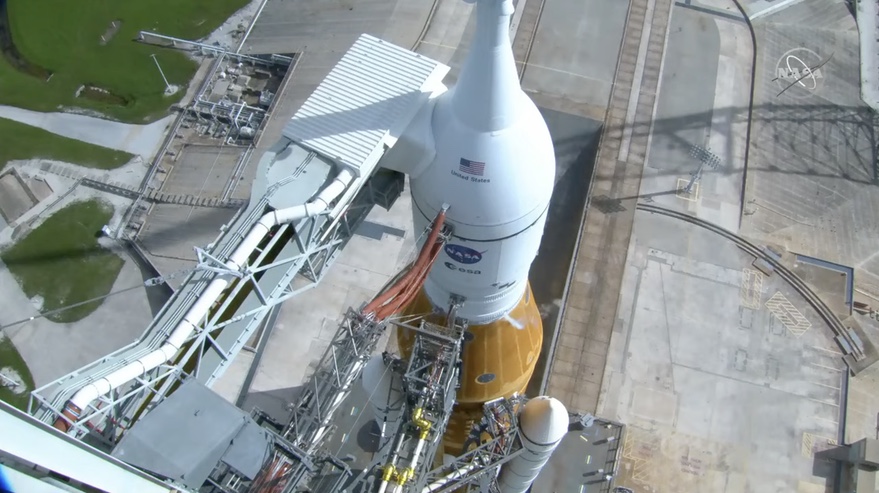PARIS — NASA said it completed all the objectives of a Space Launch System tanking test Sept. 21 despite the reoccurrence of liquid hydrogen leaks.
The day-long test at Kennedy Space Center’s Launch Complex 39B involved filling the SLS core stage and upper stage with liquid hydrogen and liquid oxygen propellants, carrying out the “kickstart bleed” of liquid hydrogen into the core stage engines and a “pre-press” test of the liquid hydrogen tank. The test was designed to confirm that changes such as replacement of seals and a new loading procedure would prevent hydrogen leaks seen in the previous launch attempt Sept. 3.
Early in the test, though, controllers reported a liquid hydrogen leak in the tail service mast umbilical, where liquid hydrogen is transferred from ground systems to the core stage, that exceeded limits and temporarily stopped loading. Warming the connection of the umbilical to the core stage then cooling it appeared to work, with the leak falling well below the limit of 4% concentration of hydrogen but not completely going away.
Another hydrogen leak took place during the pre-press test on a second, smaller liquid hydrogen line, with concentrations as high as 5%. Engineers continued the test and the leak diminished over time.
NASA said at the conclusion of the test that they met all of their objectives but stopped short of declaring they were ready to proceed with a launch at the next opportunity, Sept. 27.
“I think the test went really well,” said Charlie Blackwell-Thompson, NASA Artemis 1 launch director, during a NASA TV interview shortly after the end of the tanking test. “All of the objectives that we set out to do we were able to accomplish today.”
She said, though, it was premature to declare the vehicle ready for another launch attempt. “I think we’ll take the data and we’ll go see what it tells us,” she said. “I don’t like to get ahead of the data, and so I’d like the team to have the opportunity to go look at it to see if there are changes we need to make to our loading procedure, our timelines, or if we’re good as is.”
The tanking test is not the only factor influencing a launch decision. NASA is still working with the Eastern Range to secure a waiver for the SLS flight termination system, whose certification expired at the end of the previous launch period in early September. The U.S. Space Force, which operates the range, was not expected to decide on a waiver until after the tanking test.
Tropical weather could also play a factor. A system currently called Invest 98L is forming the Caribbean that is forecast to become a tropical storm within the next few days and could head towards Florida, based on current long-range weather models. That would require NASA to at least consider rolling back the SLS to the Vehicle Assembly Building.
Jeremy Parsons, deputy manager of NASA’s Exploration Ground Systems program, said at a Sept. 19 briefing that it would take about three days to get the vehicle back in the VAB.
